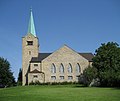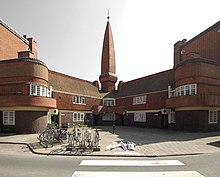Expressionism (architecture)
Expressionist architecture is almost exclusively in Germany in the period from the end of the First World War until the late 1920s practiced architectural style .
For the first time in 1913 Adolf Behne compared the architecture of Bruno Taut in the magazine Pan with the current development of painting and called it “ expressionistic ” in its innermost sense . Many of the architects had been active in the Deutscher Werkbund since 1907 and were influenced by Art Nouveau , most of them later turned to New Building .
Brick Expressionism is a special form that is particularly widespread in northern Germany .
Mark
In contrast to New Objectivity , Expressionist architecture used round and jagged shapes. The special plasticity of the buildings is based on the influence of art, especially sculpture, as propagated by the Art Workers' Council and emphasizes manual construction methods.
Brick buildings are particularly typical of expressionist architecture. In addition, concrete was also used. With the building material, which was still quite new around 1920, experiments were carried out in all styles of the time. Expressionism was particularly suited to the possibilities of curved forms. The Einstein Tower in Potsdam also gives the impression of being made of concrete and was planned that way. In fact, it was bricked up and then plastered - probably the cladding technology was still causing too big problems.
The tendency towards a total work of art is striking in almost all buildings and interiors . Sculptures, especially as reliefs , were often incorporated into the architecture. The young film also offered space for architectural fantasies, so Hans Poelzig built the film architecture for “ The Golem as He Came into the World ” in 1920 . Many expressionist designs, however, remained an unbuilt utopia .
Architects and buildings
Germany

For most architects, Expressionism was a short but intense phase in their work. This applies e.g. B. for Hans Poelzig , who later turned to the New Objectivity . From him u. a. the renovation of the large theater in Berlin (1918–1919). The stalactite-like interior architecture became particularly famous.
1920–1921 Erich Mendelsohn built one of the most famous expressionist buildings: the Einstein Tower in Potsdam-Babelsberg.
Some Bauhaus projects , such as the “ Haus Sommerfeld ” in Berlin by Walter Gropius and Adolf Meyer, were still expressionistic in 1920. The house was planned as an expressionist total work of art. Accordingly, Gropius and Meyer worked closely with the wood artist Jost Schmidt and with Josef Albers , who created the colored glass windows.
By Fritz Hoger the 1922-1924 built originate Chile house in Hamburg and the indicator skyscraper in Hanover from 1927 to 1928.
Bernhard Hoetger worked as a sculptor in Worpswede and created the famous Böttcherstraße in Bremen until 1931 .
Even Hans Scharoun had the Expressionist architects circle after World War Crystal Chain of Bruno Taut connected and in 1926 he joined the Union of Architects The ring at. His later buildings, such as the famous Philharmonie in Berlin (1956–1963), which are classified as organic , still reveal Scharoun's expressionist past.
The architect Gottfried Böhm created many church buildings in the 1960s, which have expressive expression through their plasticity and the predominantly used building material concrete. During this time, various artists also developed new approaches to the construction of Waldorf schools that have strong expressive elements.
Other expressionist architecture or buildings with expressionist echoes:
- Agnespost in Munich, 1925 to 1926 Robert Vorhoelzer and Franz Holzhammer
- Volkshaus Rotthausen and Hans-Sachs-Haus in Gelsenkirchen (both Alfred Fischer, 1920–1921 and 1924–1927)
- Hat factory Friedrich Steinberg, Herrmann & Co. in Luckenwalde (Erich Mendelsohn, 1921–1923)
- St. Paulusheim High School in Bruchsal (Hans Herkommer, 1921–1923)
- Martin Luther Church (Ulm) by Theodor Veil, 1926–1928, Zinglerstrasse
- Pallottine Church of St. John the Baptist (Freising) , 1928–1930 by Jan Hubert Pinand
- Converted old Stuttgart train station, Bolzstrasse
- Oberpostdirektion Stuttgart, Lautenschlagerstraße
- Schuster House, called Haus Wylerberg , near Kleve by Otto Bartning (1924)
- Water tower for the Zeipau lignite and roof stone works in Zeipau (Lower Silesia) (Szczepanów, Iłowa municipality , Poland) by Otto Bartning (1925)
- Town hall (completed in 1930) and main train station in Oberhausen
- Holy Cross Church in Gelsenkirchen-Ückendorf by Josef Franke
- Evangelical Kreuzkirche in Berlin-Schmargendorf
- " Bastei " in Cologne on the banks of the Rhine
- Technical administration building of Hoechst AG in Frankfurt-Höchst, 1921–1924 by Peter Behrens
- Church of St. Bonifatius in Frankfurt-Sachsenhausen
- The Friedenskirche in Frankfurt-Gallus
- The Künstlerhaus Mousonturm in Frankfurt-Ostend
- Borsigturm in Berlin-Tegel, 1922–1925 by Eugen Schmohl
- Cammann high-rise in Chemnitz, 1923–1926 by Willy Schönfeld
- Ullsteinhaus in Berlin-Tempelhof, 1925–1927 by Eugen Schmohl
- Chapel of the cemetery of the Protestant parish in Glienicke / Nordbahn , 1928 by Paul Poser
- Tower of the Catholic parish church of St. Joseph and Medardus in Lüdenscheid, 1927–1929
- Housing estates on Zeppelinstrasse and Adamstrasse in Berlin-Spandau, 1923–1927 by Richard Ermisch
- Villa Scheid with a listed park, 1931–1933 by Otto Scheid
- The salamander area in Kornwestheim
- The Evangelical Kreuzkirche in Dortmund-Berghofen, 1929 by L.Behrens
- The catholic parish church St. Ulrich in Geislingen (Zollernalbkreis) 1928
- Elephant house, free flight aviaries, bear castle and others in Leipzig Zoo , 1924–1929, as well as residential ensemble on Lößniger Straße (1925), Leipzig, by Carl James Bühring
Chilehaus in Hamburg
Church on Hohenzollernplatz in Berlin
Holy Cross Church, Gelsenkirchen-Ückendorf
Böttcherstrasse in Bremen
In the Modersohn-Becker-Museum , Bremen
Ullsteinhaus in Berlin-Tempelhof
Technical administration building of Hoechst AG in Frankfurt
Former Capuchin monastery (1929) next to the pilgrimage church Maria Einsiedel (Gernsheim)
Agnespost in Munich
Outside of Germany
in Wrocław / Breslau, today Poland, the Brick Expressionist Postal Check Office in Breslau , designed by the government builder and later post building officer Lothar Neumann (1891–1963), with ceramic reliefs by Felix Kupsch , built by Huta Hoch- und Tiefbau , 1926–1929
Outside Germany, the Amsterdam School with Michel de Klerk ( Het Schip ) was important.
The anthroposophical building of the Goetheanum in Dornach (Switzerland), which was built in 1924–1928 based on a design by Rudolf Steiner , also shows very strong references to Expressionism.
The Grundtvig Church in Copenhagen and the Hallgrímskirkja in Reykjavík are examples of sacred buildings influenced by Expressionism.
In Tallinn , for example, there is the new town hall ( Tallinna Linnavalitsus ) and the Sakala house .
literature
- Christoph Rauhut, Niels Lehmann (ed.): Fragments of Metropolis: Berlins expressionistisches Erbe , Hirmer-Verlag 2015, ISBN 978-3777422909 .
- Christoph Rauhut, Niels Lehmann (ed.): Fragments of Metropolis Rhein & Ruhr: The expressionist legacy of the Rhine and Ruhr , Hirmer-Verlag, ISBN 978-3-7774-2772-0 .
- Christoph Rauhut, Niels Lehmann (ed.): Fragments of Metropolis - East | East: The expressionist legacy in Poland, the Czech Republic and Slovakia , Hirmer-Verlag, ISBN 978-3-7774-3092-8 .
- Wolfgang Pehnt: The Architecture of Expressionism. Hatje Cantz Verlag, Ostfildern-Ruit 1998, ISBN 3-7757-0668-2
Web links
Individual evidence
- ↑ Wolfgang Pehnt: The architecture of expressionism. Verlag Gerd Hatje, Ostfildern-Ruit 1998, ISBN 3-7757-0668-2 , p. 13.
- ↑ Deutsche Bauzeitung, DBZ, Das Postscheckamt in Breslau, Architect Postbauart Lothar Neumann, Breslau , 65th year., 1931, page 61: http://delibra.bg.polsl.pl/Content/13795/no9_10.pdf






















